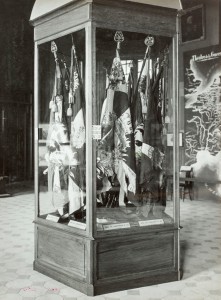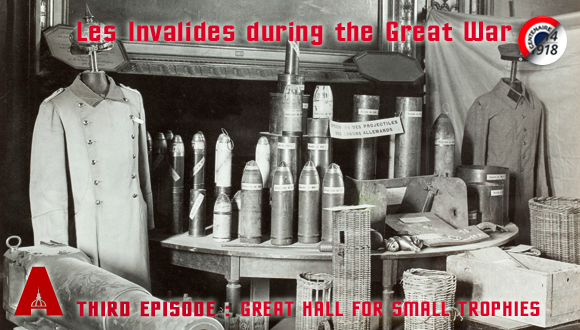 Uniforms and unexploded shells of various calibres – with their wicker carrying baskets, visible in this photograph – displayed in the great hall of the Musée de l’Armée – have a common origin: Germany. They are the equivalent, but less voluminous, of the cannon, aircraft and other machines displayed in the main courtyard, on the balconies and even in front of the main façade of the Hôtel des Invalides.
Uniforms and unexploded shells of various calibres – with their wicker carrying baskets, visible in this photograph – displayed in the great hall of the Musée de l’Armée – have a common origin: Germany. They are the equivalent, but less voluminous, of the cannon, aircraft and other machines displayed in the main courtyard, on the balconies and even in front of the main façade of the Hôtel des Invalides.
For information, General Niox, director of the Musée de l’Armée, a nd his team, have labelled each of the objects so that the public can identify them. The somewhat improvised nature of this installation can be guessed from the benches and old cannon from the past, placed as if put to one side, to protect them from visitors, and from the hangings on the panelling, there to separate the articles divided up by theme. The painting of Baron Antoine-Jean Gros, (1771-1835) entitled General Lariboisière saying goodbye to his son, a lieutenant in the 1st Rifle Regiment, at the start of the battle of the Moskowa, on 7 September 1812 shows how the great hall was previously arranged.
nd his team, have labelled each of the objects so that the public can identify them. The somewhat improvised nature of this installation can be guessed from the benches and old cannon from the past, placed as if put to one side, to protect them from visitors, and from the hangings on the panelling, there to separate the articles divided up by theme. The painting of Baron Antoine-Jean Gros, (1771-1835) entitled General Lariboisière saying goodbye to his son, a lieutenant in the 1st Rifle Regiment, at the start of the battle of the Moskowa, on 7 September 1812 shows how the great hall was previously arranged.
The pictures tell
 Have you noticed, in the photograph above, this postcard, published by the musée de l’Armée ?
Have you noticed, in the photograph above, this postcard, published by the musée de l’Armée ?
Placed at eye level on the display case,![]() it describes 9 flags captured from the enemy, with notes about each one of them.
it describes 9 flags captured from the enemy, with notes about each one of them.
Tell about the war, portray those who fought in it
The great hall of the Hôtel des Invalides was, in turn, a chapel for religious services for the disabled in the time of Louis XIV, a library and a council chamber…
In 1915, it was converted into a temporary exhibition room to display weapons, uniforms, pictures, flags and maps showing how the conflict was evolving. Two 1914 German uniforms displayed on a model gave body to the Allies main enemy. A set of paintings, water colours and drawings produced by French artists during missions to the armed forces were added by General Niox in 1915


Ajouter un commentaire